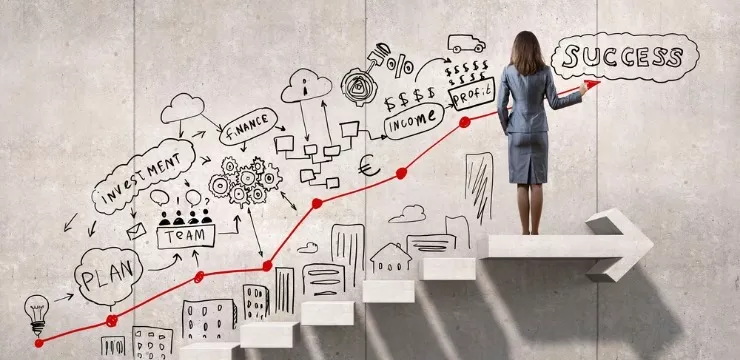
How do you build a change management process for success?
At times, change can seem overwhelming.
But it doesn’t have to be difficult.
With the right template, you can build a successful process that:
- Delivers results to stakeholders
- Keeps employees happy and productive
- Cuts costs and boosts ROI
- Builds your portfolio and bolsters your career prospects
The keys to creating a successful process are following solid change management principles and including the right ingredients.
Let’s get started.
A Change Management Process for Success – In 5 Simple Steps
Below, we’ll walk through 5 key steps that can help you build the right process for success.
Each step can – and should – be customized to fit your needs.
1. Analyze the Problem
Before you can solve your problem, you need to understand it.
Defining your problem is the first step.
It helps to approach your problem from a few dimensions:
- Organization and strategy
- Employees and motivation
- Executive and stakeholder interest
- Customer impact
For each dimension, define the problem by asking a few good questions.
For instance:
- What is the impact of the problem for this group or dimension?
- What solution would best solve the problem for this group?
- What objections and obstacles might arise?
Asking key questions like these will help you clarify the problem.
And it will help you with the next step…
2. Design a Solution
Once you have analyzed the problem from different sides, you can begin designing a solution.
That is, clarify your vision.
This is the end state you wish to reach after the change is complete.
Armed with your answers from the previous step, you can begin solving the problem.
Just as your analysis covered several dimensions, so too should your solution.
Design a solution that:
- Meets the strategic goals of the organization
- Benefits employees, boosts productivity, and cuts resistance
- Earns support from executives
- Improves the end-result for the customer
The solution, naturally, will vary greatly upon the nature of the problem.
However, because we’re discussing change management, it will certainly involve an organizational change.
Once you have a clear vision of your solution, it’s time to find out how to reach that state.
3. Choose Your Change Model
Your change model is the people-centered framework that helps you accomplish a few things.
- Help you understand organizational change from the perspective of group psychology
- Break down the change process into stages
- Give you straightforward guidelines to follow for each step
Such frameworks are must-reads in most change management courses.
A few of the most popular change models include:
- The Lewin Change Model
- Kotter’s 8-Step Model for Change
- The ADKAR Model
Each model can be customized to fit your needs.
And if these don’t meet your needs, you can find other models that offer alternative approaches.
4. Roadmap Your Process
By now, you should have these three important ingredients:
- Your problem analysis
- The vision of your solution – the “after” state
- Your change management model
Using this information, you can create your roadmap for organizational change.
Your roadmap should consist of at least three main things:
- The timeline – A 2-year change process, for instance, could be broken down into four separate 6-month periods. Each period would have a specific, measurable goal for a specific business area.
- The business area – Each change initiative will impact multiple business areas. A digital transformation effort, for instance, could impact IT, customer service, product development, and product design.
- Objectives for each stage – As mentioned, each stage should have specific objectives and goals. It can serve as a task board or calendar, where you schedule specific events, meetings, discussions, roll-outs, and so on.
More complex change programs can include more information, such as individual project names or milestones.
5. Execute, Evaluate, and Adapt
It is said that no battle plan survives contact with the enemy.
The same could also be said of change management.
Execution, therefore, is just as important as creating a process for change management success.
A key ingredient to successful execution is adaptability.
Adaptability will allow you to adjust your “battle plan” as needed.
This type of responsiveness has become crucial in today’s fast-paced world, where change is the norm.
To stay agile and adaptable:
- Continually get feedback from employees, executives, and stakeholders
- Keep your change program open to change – if goals or processes need changing, be ready
- Measure and analyze data continuously, then fix what doesn’t work
Tracking your progress will help you measure your rate of success.
It will help you demonstrate to yourself and others that the program is meeting its objectives.
Final Thoughts
A change management process for success requires some effort.
Though we have broken the process down here into 5 simple steps, remember that it does take work.
However, by following a template such as this, you can:
- Avoid pitfalls that can ruin organizational change efforts
- Streamline your own workflow
- Cut costs and get better results
- And ensure you don’t forget anything important
Of course, don’t forget that this template should be customized to fit your own needs.
To get results, the important thing is that you develop a complete roadmap and execute it.
WalkMe Team
WalkMe spearheaded the Digital Adoption Platform (DAP) for associations to use the maximum capacity of their advanced resources. Utilizing man-made consciousness, AI, and context-oriented direction, WalkMe adds a powerful UI layer to raise the computerized proficiency, everything being equal.



